2010 Hyundai Genesis Coupe flat tire
[x] Cancel search: flat tirePage 279 of 322
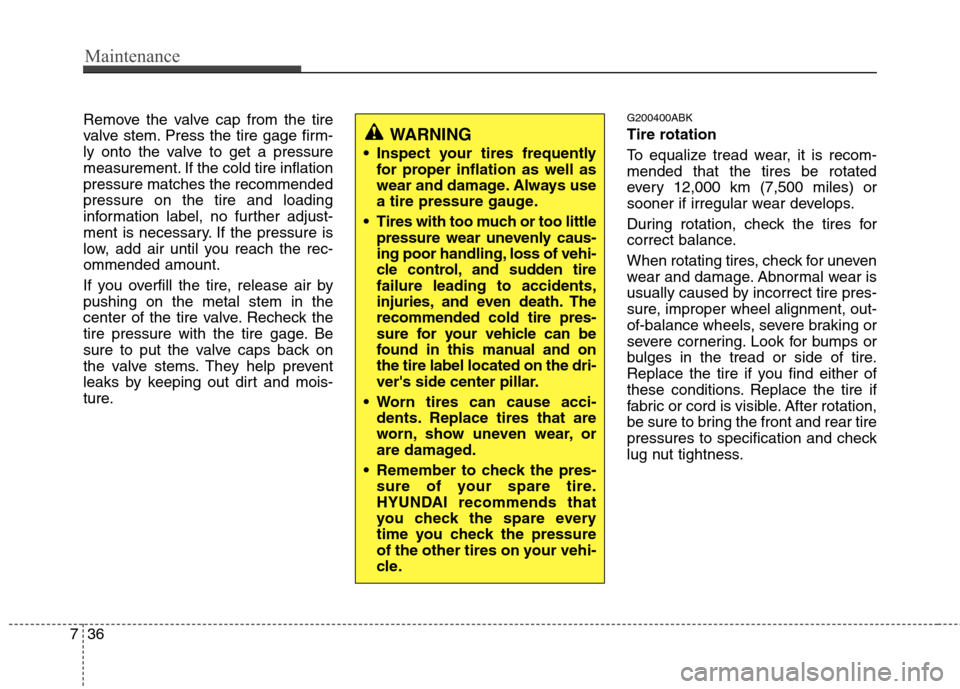
Maintenance
36
7
Remove the valve cap from the tire
valve stem. Press the tire gage firm-
ly onto the valve to get a pressure
measurement. If the cold tire inflationpressure matches the recommendedpressure on the tire and loading
information label, no further adjust-
ment is necessary. If the pressure is
low, add air until you reach the rec-ommended amount.
If you overfill the tire, release air by pushing on the metal stem in the
center of the tire valve. Recheck the
tire pressure with the tire gage. Be
sure to put the valve caps back on
the valve stems. They help prevent
leaks by keeping out dirt and mois-
ture. G200400ABK
Tire rotation
To equalize tread wear, it is recom- mended that the tires be rotated
every 12,000 km (7,500 miles) or
sooner if irregular wear develops.
During rotation, check the tires for
correct balance.
When rotating tires, check for uneven
wear and damage. Abnormal wear is
usually caused by incorrect tire pres-
sure, improper wheel alignment, out-
of-balance wheels, severe braking or
severe cornering. Look for bumps or
bulges in the tread or side of tire.
Replace the tire if you find either of
these conditions. Replace the tire if
fabric or cord is visible. After rotation,
be sure to bring the front and rear tire
pressures to specification and check
lug nut tightness.
WARNING
Inspect your tires frequently for proper inflation as well as
wear and damage. Always use
a tire pressure gauge.
Tires with too much or too little pressure wear unevenly caus-
ing poor handling, loss of vehi-
cle control, and sudden tirefailure leading to accidents,
injuries, and even death. Therecommended cold tire pres-
sure for your vehicle can be
found in this manual and onthe tire label located on the dri-
ver's side center pillar.
Worn tires can cause acci- dents. Replace tires that are
worn, show uneven wear, or
are damaged.
Remember to check the pres- sure of your spare tire.
HYUNDAI recommends that
you check the spare every
time you check the pressure
of the other tires on your vehi-
cle.
Page 283 of 322
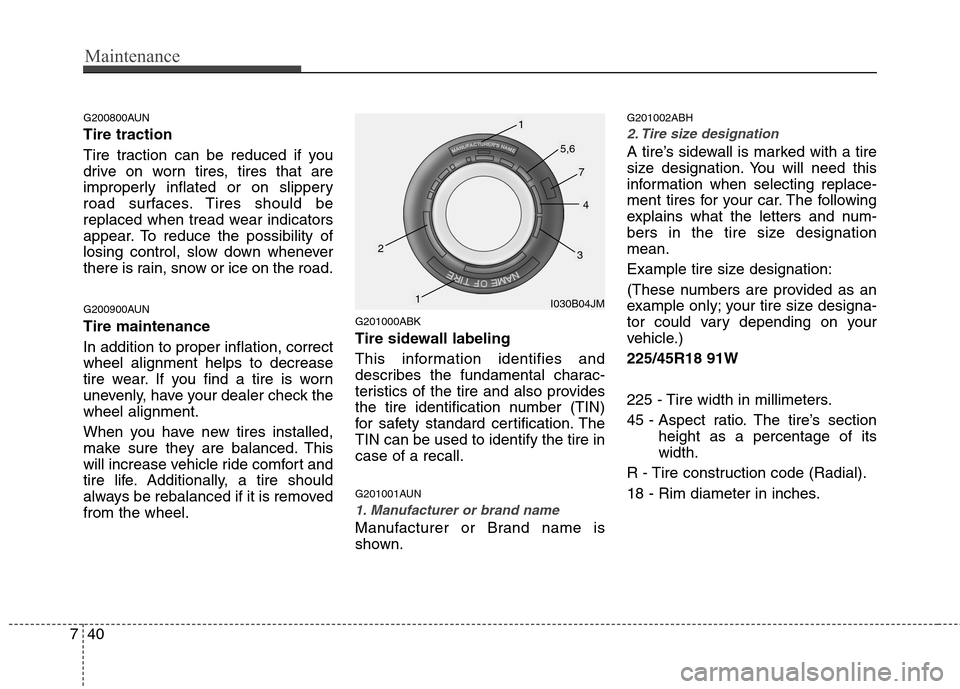
Maintenance
40
7
G200800AUN Tire traction
Tire traction can be reduced if you
drive on worn tires, tires that are
improperly inflated or on slippery
road surfaces. Tires should be
replaced when tread wear indicators
appear. To reduce the possibility of
losing control, slow down whenever
there is rain, snow or ice on the road.
G200900AUN Tire maintenance In addition to proper inflation, correct wheel alignment helps to decrease
tire wear. If you find a tire is worn
unevenly, have your dealer check thewheel alignment.
When you have new tires installed,
make sure they are balanced. This
will increase vehicle ride comfort and
tire life. Additionally, a tire should
always be rebalanced if it is removedfrom the wheel. G201000ABK
Tire sidewall labeling
This information identifies and
describes the fundamental charac-
teristics of the tire and also provides
the tire identification number (TIN)
for safety standard certification. TheTIN can be used to identify the tire incase of a recall.
G201001AUN
1. Manufacturer or brand name
Manufacturer or Brand name is
shown.G201002ABH
2. Tire size designation
A tire’s sidewall is marked with a tire
size designation. You will need this
information when selecting replace-
ment tires for your car. The following
explains what the letters and num-
bers in the tire size designationmean.
Example tire size designation:
(These numbers are provided as an
example only; your tire size designa-
tor could vary depending on your
vehicle.) 225/45R18 91W
225 - Tire width in millimeters.
45 - Aspect ratio. The tire’s section
height as a percentage of its width.
R - Tire construction code (Radial).
18 - Rim diameter in inches.
I030B04JM
1
1
23
4
5,6
7
Page 285 of 322
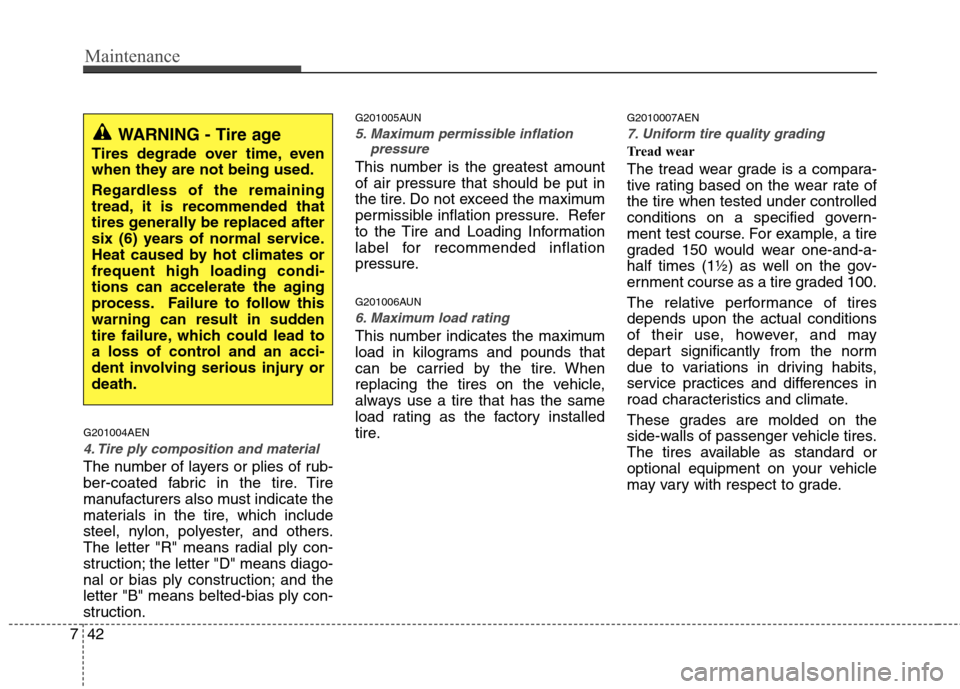
Maintenance
42
7
G201004AEN
4. Tire ply composition and material
The number of layers or plies of rub-
ber-coated fabric in the tire. Tire
manufacturers also must indicate the
materials in the tire, which include
steel, nylon, polyester, and others.
The letter "R" means radial ply con-
struction; the letter "D" means diago-
nal or bias ply construction; and theletter "B" means belted-bias ply con-
struction. G201005AUN
5. Maximum permissible inflation
pressure
This number is the greatest amount of air pressure that should be put in
the tire. Do not exceed the maximum
permissible inflation pressure. Refer
to the Tire and Loading Information
label for recommended inflation
pressure.
G201006AUN
6. Maximum load rating
This number indicates the maximum
load in kilograms and pounds that
can be carried by the tire. When
replacing the tires on the vehicle,
always use a tire that has the same
load rating as the factory installed
tire. G2010007AEN
7. Uniform tire quality grading
Tread wear
The tread wear grade is a compara-
tive rating based on the wear rate ofthe tire when tested under controlled
conditions on a specified govern-
ment test course. For example, a tire
graded 150 would wear one-and-a-
half times (1½) as well on the gov-
ernment course as a tire graded 100.
The relative performance of tires depends upon the actual conditions
of their use, however, and may
depart significantly from the norm
due to variations in driving habits,
service practices and differences in
road characteristics and climate.
These grades are molded on the
side-walls of passenger vehicle tires.
The tires available as standard or
optional equipment on your vehicle
may vary with respect to grade.
WARNING - Tire age
Tires degrade over time, even
when they are not being used.
Regardless of the remaining
tread, it is recommended that
tires generally be replaced after
six (6) years of normal service.
Heat caused by hot climates orfrequent high loading condi-
tions can accelerate the aging
process. Failure to follow this
warning can result in sudden
tire failure, which could lead to
a loss of control and an acci-
dent involving serious injury ordeath.
Page 286 of 322
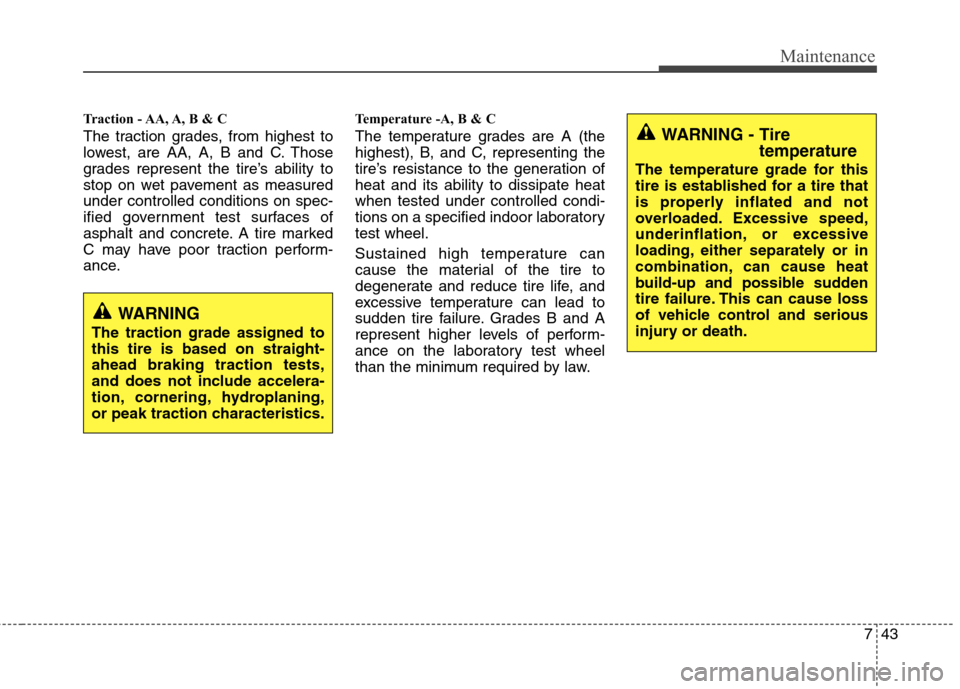
743
Maintenance
Traction - AA, A, B & C
The traction grades, from highest to
lowest, are AA, A, B and C. Those
grades represent the tire’s ability to
stop on wet pavement as measuredunder controlled conditions on spec-
ified government test surfaces of
asphalt and concrete. A tire marked
C may have poor traction perform-
ance.Temperature -A, B & C
The temperature grades are A (the
highest), B, and C, representing the
tire’s resistance to the generation ofheat and its ability to dissipate heatwhen tested under controlled condi-
tions on a specified indoor laboratorytest wheel.
Sustained high temperature can
cause the material of the tire to
degenerate and reduce tire life, and
excessive temperature can lead to
sudden tire failure. Grades B and A
represent higher levels of perform-
ance on the laboratory test wheel
than the minimum required by law.
WARNING
The traction grade assigned to this tire is based on straight-ahead braking traction tests,
and does not include accelera-
tion, cornering, hydroplaning,
or peak traction characteristics.
WARNING - Tire temperature
The temperature grade for this
tire is established for a tire that
is properly inflated and not
overloaded. Excessive speed,
underinflation, or excessive
loading, either separately or in
combination, can cause heat
build-up and possible sudden
tire failure. This can cause loss
of vehicle control and serious
injury or death.
Page 314 of 322
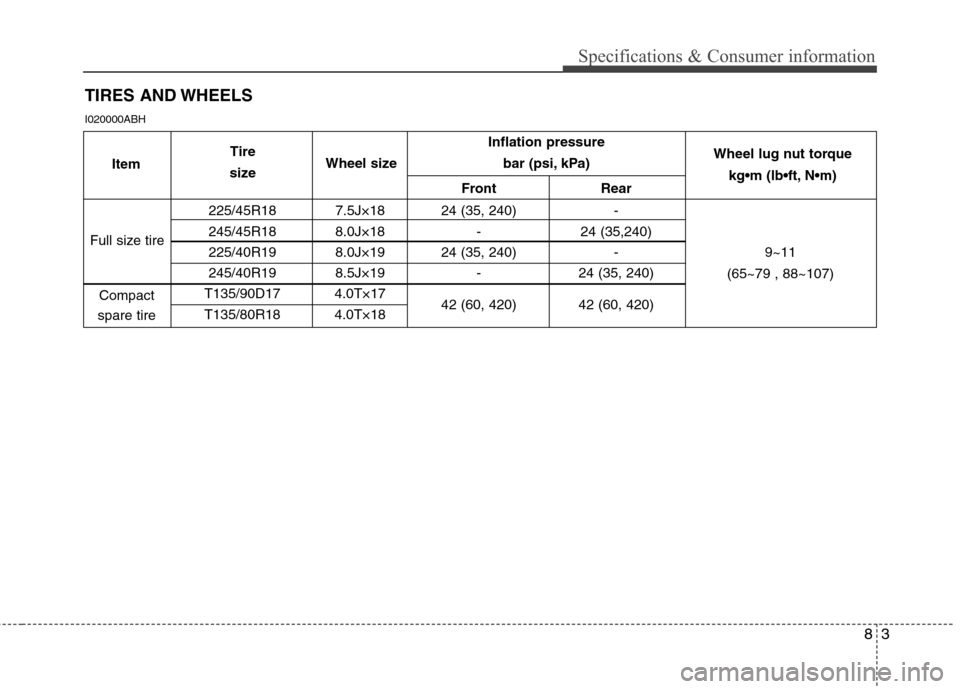
83
Specifications & Consumer information
TIRES AND WHEELS
I020000ABH
Inflation pressure bar (psi, kPa)
Front Rear
225/45R18 7.5J×18 24 (35, 240) -
245/45R18 8.0J×18 - 24 (35,240)
225/40R19 8.0J×19 24 (35, 240) -
245/40R19 8.5J×19 - 24 (35, 240)
T135/90D17 4.0T×17 42 (60, 420) 42 (60, 420)
T135/80R18 4.0T×18
Full size tire
Compact
spare tire Wheel lug nut torque
kg•m (lb N
9~11
(65~79 , 88~107)
Item
Tire
size Wheel size
Page 321 of 322

I3
Index
If the engine overheats ·················································· 6-6
If the engine will not start ············································· 6-3
If you have a flat tire ····················································· 6-7
In case of an emergency while driving ·························· 6-2
Indicator symbols on the instrument cluster ················· 1-5
Instrument cluster ························································ 4-37
Instrument panel overview ············································ 2-3
Interior features ··························································· 4-92
Interior light ································································· 4-65
Interior overview ··························································· 2-2
Key ················································································· 5-4
Keys ··············································································· 4-3
Light bulbs ··································································· 7-53
Lighting ······································································· 4-57
Maintenance services ····················································· 7-4
Manual climate control system ··································· 4-68
Manual transmission ···················································· 5-12
Manual transmission fluid ··········································· 7-23
Mirrors ········································································· 4-33 Owner maintenance ······················································· 7-5
Parking brake ······························································· 7-24
Power steering fluid ····················································· 7-22
Rear parking assist system ·········································· 4-54
Recommended lubricants and capacities ······················· 8-4
Remote keyless entry ····················································· 4-8
Road warning ································································· 6-2
Scheduled maintenance service ····································· 7-7
Seat belts ······································································ 3-14
Seats ··············································································· 3-2
Smart key ······································································· 4-5
Special driving conditions ··········································· 5-38
Steering wheel ····························································· 4-31
Storage compartment ··················································· 4-90
Sunroof ········································································ 4-28
I
K
L
M
O
P
R
S